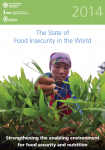The Millennium Development Goal (MDG) hunger target, to halve the proportion of undernourished people in developing countries by 2015, is within reach, according to 'The State of Food Insecurity (SOFI) in the World 2014: Strengthening the enabling environment for food security and nutrition.' SOFI 2014 cautions, however, that food security remains a challenge, and calls for sustained, high-level political commitment to food security and nutrition to eradicate hunger.
 16 September 2014: The Millennium Development Goal (MDG) hunger target, to halve the proportion of undernourished people in developing countries by 2015, is within reach, according to ‘The State of Food Insecurity (SOFI) in the World 2014: Strengthening the enabling environment for food security and nutrition.’ SOFI 2014 cautions, however, that food security remains a challenge, and calls for sustained, high-level political commitment to food security and nutrition to eradicate hunger.
16 September 2014: The Millennium Development Goal (MDG) hunger target, to halve the proportion of undernourished people in developing countries by 2015, is within reach, according to ‘The State of Food Insecurity (SOFI) in the World 2014: Strengthening the enabling environment for food security and nutrition.’ SOFI 2014 cautions, however, that food security remains a challenge, and calls for sustained, high-level political commitment to food security and nutrition to eradicate hunger.
The Food and Agriculture Organization of the UN (FAO), the International Fund for Agricultural Development (IFAD) and the World Food Programme (WFP) launched SOFI 2014 at a meeting of the Committee on World Food Security (CFS) at FAO headquarters in Rome, Italy, on 16 September 2014.
SOFI 2014 provides estimates of progress towards the MDG and World Food Summit (WFS) hunger targets, noting that 63 countries have achieved the MDG hunger target, and 25 countries have achieved the WFS target. In 2012-2014, an estimated 805 million people were chronically undernourished. This figure represents a decrease from 18.7% to 11.3% globally, and from 23.4% to 13.5% for developing countries.
Latin America and the Caribbean (LAC) have achieved the MDG target, while Latin America has met the WFS target. Sub-Saharan Africa has the highest prevalence of undernourishment, with over one in four people chronically malnourished. Asia is home to 526 million hungry people, the largest amount globally. Still, SOFI 2014 notes, access to food has improved “rapidly” in countries in Eastern and Southeastern Asia that have experienced economic progress.
The report presents case studies from seven countries: Bolivia, Brazil, Haiti, Indonesia, Madagascar, Malawi and Yemen. Brazil has achieved the MDG and WFS targets through its Zero Hunger programme, which links social protection with family farming policies. Indonesia has established institutions to improve food security and nutrition that involve coordination across ministries, NGOs and communities. Malawi’s commitment to boost maize production helped the country to reach the MDG target, although malnutrition remains a challenge.
The report recommends placing food security and nutrition at the top of the political agenda, and creating an enabling environment for improving food security and nutrition. It further recommends an integrated approach to hunger reduction that includes: better access to land measures; measures to promote rural development; social protection for the most vulnerable, including strengthened resilience to natural disasters and conflicts; and nutrition programmes focused on mothers and children under five. [FAO Press Release] [Publication: The State of Food Insecurity in the World 2014]